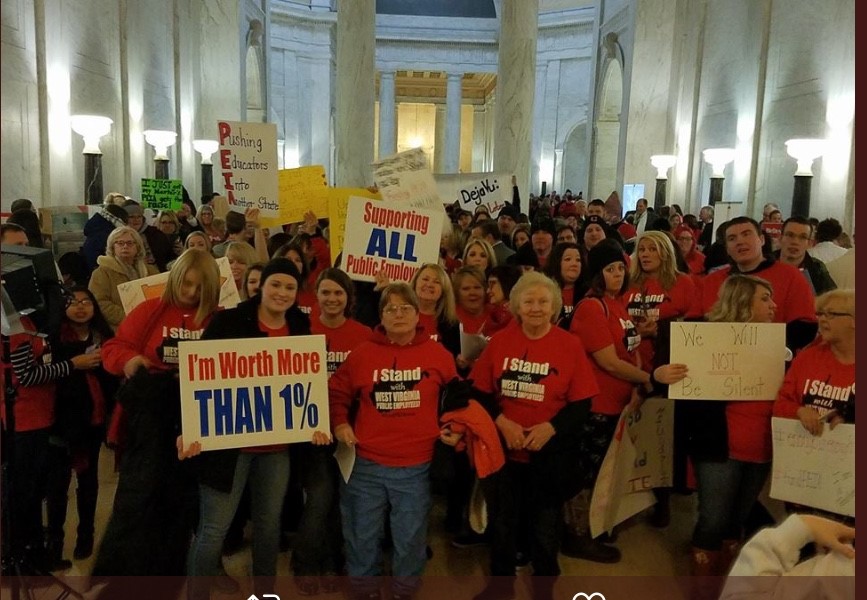
The historic West Virginia teachers' strike in 2018. Photo: Lida Shepherd/AFSC
It’s official. Unions raise wages for members, reduce what has been called “toxic inequality,” help narrow the racial and gender income and wealth divide, and improve access to family-friendly benefits like paid sick days, vacations, health care, and pensions. And they help set the standards for other employers that benefit nonunion workers as well.
All that and more is included in a new report by the U.S. Treasury Department report titled Labor Unions and the Middle Class, which also found benefits for the economy at large, something that would increase with a growing the labor movement: “More broadly, strengthened unions and expanded union membership have the potential to contribute to economywide growth and resilience.”
So, what can be done to support unions and their members, especially when they’re on strike? In a word, plenty.
-
For starters, if you’re lucky enough to be in a union, try to be active in it. Attend meetings, participate in calls, take part in local labor councils, subscribe to alerts and updates, read union publications, and show up as needed.
-
If you’re eligible to join a union but haven’t yet—which sometimes happens in so-called “right to work” states or with public employees without collective bargaining—sign up. It gives you a layer of protection on the job and strengthens workers’ power.
-
If your workplace doesn’t have a union, consider trying to organize one. This isn’t always easy, and some employers retaliate and illegally fire leaders, but it can be done, as we’ve seen with the success of the Amazon Labor Union. Sometimes it’s as easy as getting a majority of eligible workers to sign cards. At other times, it can be more adversarial and require a National Labor Relations Board election. You can read more about how to here. As we say in West Virginia, if you’re feeling froggy hop on!
-
Buy union when you can and try to avoid spending money at anti-union businesses. One easy way to check is to visit the AFL-CIO’s Union Label website, which regularly publishes information on what companies are labor friendly and which are being boycotted for anti-union practices.
-
Learn about the history of workers’ movements in the U.S. and around the world and how these have contributed to other liberation struggles. There are plenty of inspiring stories. A few years back, PBS compiled a list of books about the U.S. labor movement that might be a good place to start. There are also plenty of websites, including this one from the AFL-CIO.
Supporting strikes and other labor actions
Sometimes, the labor movement is really on the move, as we’ve seen in the Teamsters’ successful contract negotiation with UPS, the Hollywood strikes by actors and writers, and especially the current historic strike by members of the United Auto Workers union.
Examples of labor actions that need public support are informational pickets, where members highlight grievances with employers; organizing drives in which workers strive for union recognition; boycotts and strikes, which are classic examples of nonviolent noncooperation; and lockouts, where employees are excluded from the worksite until conditions are met--or the workers win.
When you see an informational picket, it’s just a matter of honking, visiting, taking in the information, and acting on it as appropriate. To support organizing drives, take direction from those who are doing the organizing.
Strikes and lockouts are a different story. In recent decades, the power of organized wealth has far outgrown that of organized people and U.S. labor law is much more restrictive than many other countries. Further, these struggles impose financial hardships on workers, who often rely on reduced income from union strike support funds. Nobody strikes for the fun of it. It’s stressful and sometimes physically dangerous—but it can also be very exciting and, yes, even fun!
This probably doesn’t need saying, but crossing a union picket line and/or taking the job of a striking worker is a no-no. On the positive side, you can start by just showing support. This can be as simple as honking when you pass one, visiting the workers, having conversations, asking what is needed, walking the picket line, carrying signs, taking and sharing pictures of union actions, donating money, or bringing pizza or donuts. All that sounds simple, but morale is an important factor in labor disputes, especially long ones. This is also an excellent opportunity for new activists to learn and grow.
There are plenty of other ways to publicly express support, either as an individual or a group. The UAW, for example, has an informational website with an online petition, action ideas (including canvassing car dealerships of the corporations involved), and support statements that can be shared electronically.
Often yard signs expressing support are available from unions. Sometimes local businesses can be persuaded to post signs expressing support. It’s also good to chime in on social and traditional media wherever available, including talk radio, letters to the editor, and op-eds.
Group activities can include covering the picket lines in shifts; organizing public forums, rallies, or town hall meetings in support; setting up speaking engagements for strikers; sign-making parties; fundraising activities; turning out for solidarity events; and more. Picketers may also need audiovisual gear, microphones, or other equipment. And don’t forget food, music, and celebrations.
On a personal level, struggles like this can create friendships, alliances, and memories that will last a lifetime. And the ripple effects can last for generations. I was lucky enough to begin my career with AFSC during the United Mine Workers historic strike against Pittston Coal in 1989-90, a baptism by fire. I lived and breathed it for months and it was one of the most intense and meaningful experiences of my life. Several others would follow that have been the subject of books and documentaries.
There’s nothing like it. Don’t miss out.
